MXA RACE TEST: THE REAL TEST OF THE 2020 HUSQVARNA FC450
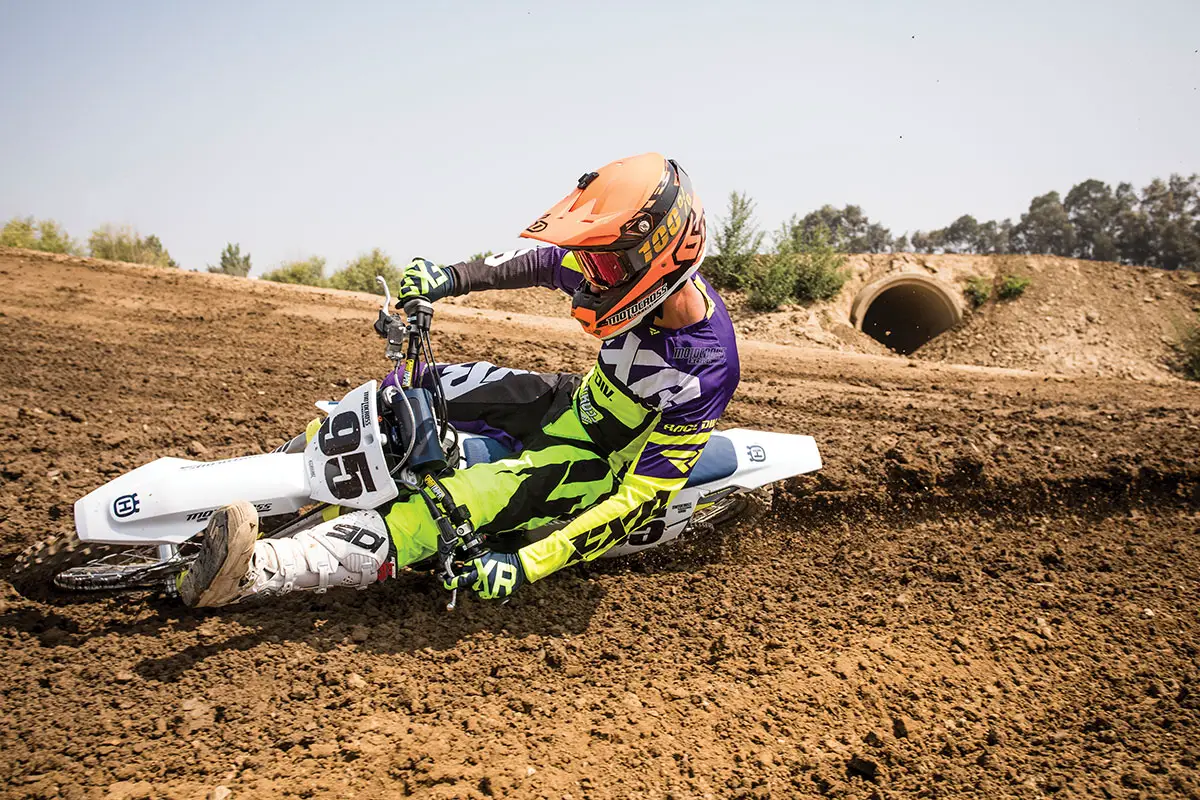
MXA RACE TEST: THE REAL TEST OF THE 2020 HUSQVARNA FC450
Q: FIRST AND FOREMOST, IS THE 2020 HUSQVARNA FC450 BETTER THAN THE 2019 FC450?
A: Yes. It would be wrong for us to say that Husqvarna has been KTM’s lapdog since its reintroduction to the American market in 2014, but it wouldn’t be wrong for us to think it. Husqvarna has been a bouncing ball since the Swedes sold it to Cagiva in 1987. BMW took it over in 2007, and KTM bought it in 2013. When you change hands so many times, you lose your heritage—and when KTM’s management decided to platform share all future Husqvarnas, they erased the genetic trail. The Mattighofen execs hate when people call Husqvarnas “white KTMs,” but that is exactly what they are. Apart from cosmetic differences and the occasional component swapping between Brembo and Magura, there are no mechanical differences between white and orange. That isn’t the worst of it. KTM plays up Husqvarna’s Swedish heritage with blue and yellow highlights, even hosting international press intros in Sweden, while having zero Swedish roots. To many, Husqvarna was the motorcycle version of Dolly the cloned sheep—no family history, no shared genes, no unique features and no underlying doctrine. It was a “white KTM.”
Until now! In what could easily be considered an uprising, Husqvarna has finally gotten something that it can call its own. You may have thought that the plastic airbox/subframe was KTM’s definitive statement of autonomy, but, in truth, that was a hand-me-down from Husaberg (which KTM killed after it bought Husky from BMW). What does Husqvarna have in 2020 that it hasn’t had since the good old days at Odeshog? A philosophy about how its bikes should perform, whom they should be built for and a willingness to break away from KTM and stand on its own two wheels.
Q: WHAT MAKES THE 2020 HUSQVARNA FC450 SO DIFFERENT FROM THE 2020 KTM 450SXF?
A: Don’t mistake the Husky uprising for an all-out rebellion. If anything, it is a small skirmish over the direction that Husqvarna should take—and even though it was only a small battle, fought and won on a field that few will remember in a year or two, it was a transformative first step towards building a new identity for the Swedish/Italian/German/Austrian brand. MXA has always hoped that Husqvarna would have more leeway in breaking the bonds that tie it to being a KTM clone. We’d like to see unique Husqvarna models. For example, instead of a Husky FC350 that pantomimes the KTM 350SXF, how about replacing it with a Husqvarna FC400? But, we are getting ahead of ourselves. Every revolution must have its first shot fired in a minor skirmish, much like at Lexington Green and Concord’s North Bridge, before dreaming of independence.
In 2020, Husqvarna broke away from KTM over the stiffness of the KTM chassis and suspension. Instead of spec’ing the exact same Xact fork and shock settings as KTM, Husqvarna decided to go softer, plusher and more forgiving on both the forks and shock in contrast to what KTM’s engineers wanted in the 450SXF suspension.
Now you may wonder what the big deal is. Why are we gushing over softer suspension as though it were a revolutionary idea? So what? Big deal. What you don’t understand, and won’t until you throw a leg over the 2020 Husqvarna, is that fluid suspension is hard to come by on modern bikes. It is either too stiff for anyone but factory riders or too soft by virtue of poor damping. There is a reason Yamaha’s SSS suspension has held sway over the suspension contenders for 14 straight years—and that is because they got it right, and left it alone. And that is what Husqvarna achieved in 2020 by going against the KTM grain.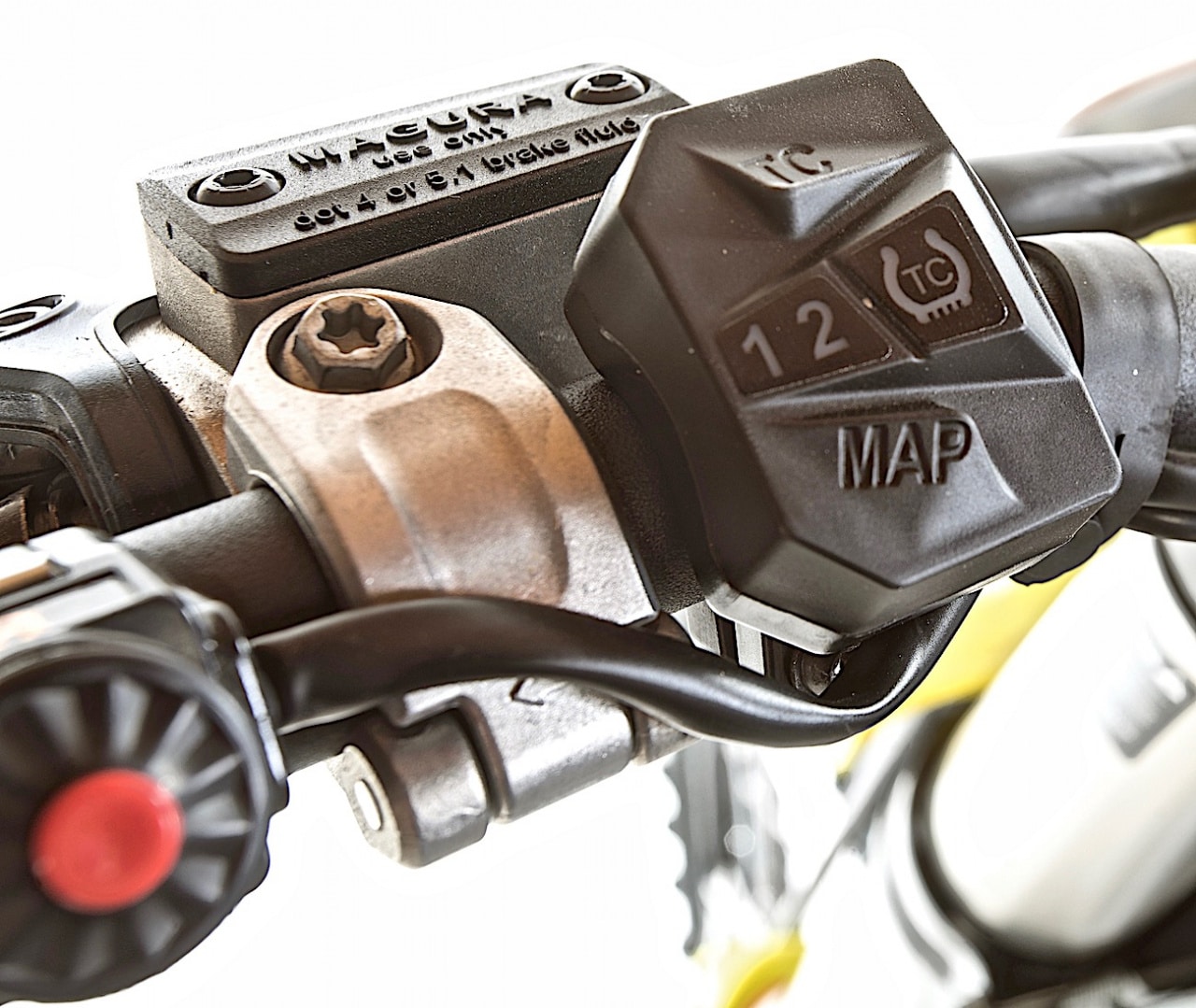
Q: WHAT DID HUSQVARNA DO TO MAKE ITS SUSPENSION SO PLUSH?
A: The first thing that Husqvarna did was to take a long hard look at the demographics of who buys motocross bikes. Guess what? It’s not AMA National racers, fast local Pros or wanna-be prodigies. It is hard-working racers, often in their late 30s and early 40s, who don’t need Supercross-stiff suspension. These riders know who they are. They know how fast they are. They know what they want. And they are tired of manufacturers building bikes for the “fast few” and then expecting their paying customers to send the forks and shock off to a hop-up shop to undo what the factory did. Husqvarna decided that instead of setting the bike up for the few and penalizing the many, it would aim for its target market, which you don’t need Sherlock Holmes to tell you is 40-year-old rich guys.
To bring the forks into line with the potential buyer, Husqvarna had WP soften the compression shim stack to make the forks softer from mid-stroke down. They eliminated free bleed in the mid-valve, because the new damping curve didn’t need it. Once they got the fork to feel ultra-plush, they fought against bottoming by raising the oil height from the 200cc that KTM uses to 220cc—this didn’t have any effect on most of the fork’s stroke but kicked in more bottoming control at the bitter end of the travel. From there, KTM raised the recommended air pressure by 3 psi (from 152 psi to 155 psi) to hold the fork higher in its stroke early in the travel. The best thing about WP’s recommended air pressures is that they allow a lot of leeway in satisfying a specific rider’s or track’s needs. It’s not uncommon for fast riders to go as high as 160 psi and Vets to go as low as 135 psi.
Make no mistake about it, Husqvarna succeeded in lessening mid-stroke harshness, smoothing out the action of the fork, making the feel much more responsive, improving front tire contact and increasing overall comfort from the front of the FC450 by 30 percent or more. It’s like a completely different fork, even though the WP internals are identical, just reshuffled in order and execution.
We admit that all is not perfect with the WP fork, although it is if you fall into the target zone that Husqvarna is aiming at, which Husky feels is the majority of FC450 buyers. If you are a Pro rider, however, the FC450 forks will be too soft. Way too soft. They will bottom with a Pro on board, but Husqvarna counters that virtually every Pro rider sends his forks out to have them re-valved, often before he even rides his Honda, Yamaha, Suzuki or Kawasaki. Pros know they are fast, just as fat guys know they are heavy and skinny guys know they are light. It is rare that a 220-pound racer doesn’t already know that he will need stiffer springs. In a unique way, Husqvarna is not punishing the majority for being slow, it is punishing the riders that skew to the far ends of the bell-shaped curve.

Q: WHAT ABOUT THE WP SHOCK?
A: It should come as no surprise that in the past, Husqvarna spec’ed the shock spring to work for fast riders on big jumps and hard landings. No more. For 2020, Husqvarna made a lighter 42 N/m spring the OEM equipment on the FC450—which is a far cry from the 48 N/m springs of a few years ago or the 45 N/m springs of the last few years. To compensate for the softer spring rate, the compression damping has been upped while the rebound has been lightened. This is logical, because on the downward stroke, the lighter spring rate will kick in less compression resistance than last year’s 45 N/m spring and, conversely, the lighter spring will need less rebound damping to control its upward swing. There is a new compression adjuster on the shock, and it is equipped with finer threads for durability.
The MXA test riders didn’t like the shock as much as they liked the forks. It seemed as though the damping was too light at the end of the stroke and not firm enough on rebound throughout the stroke. We compensated for this with additional high-speed compression (from 1.5 turns to 1.25 turns) and 5 clicks more of rebound (from 15 clicks out to 10 clicks out). We found an easy way to gauge if we were running enough compression damping—all we had to do was look under the rear fender at the skid marks left on the fender. The solution was simple—more low- and high-speed compression damping until the marks disappeared.
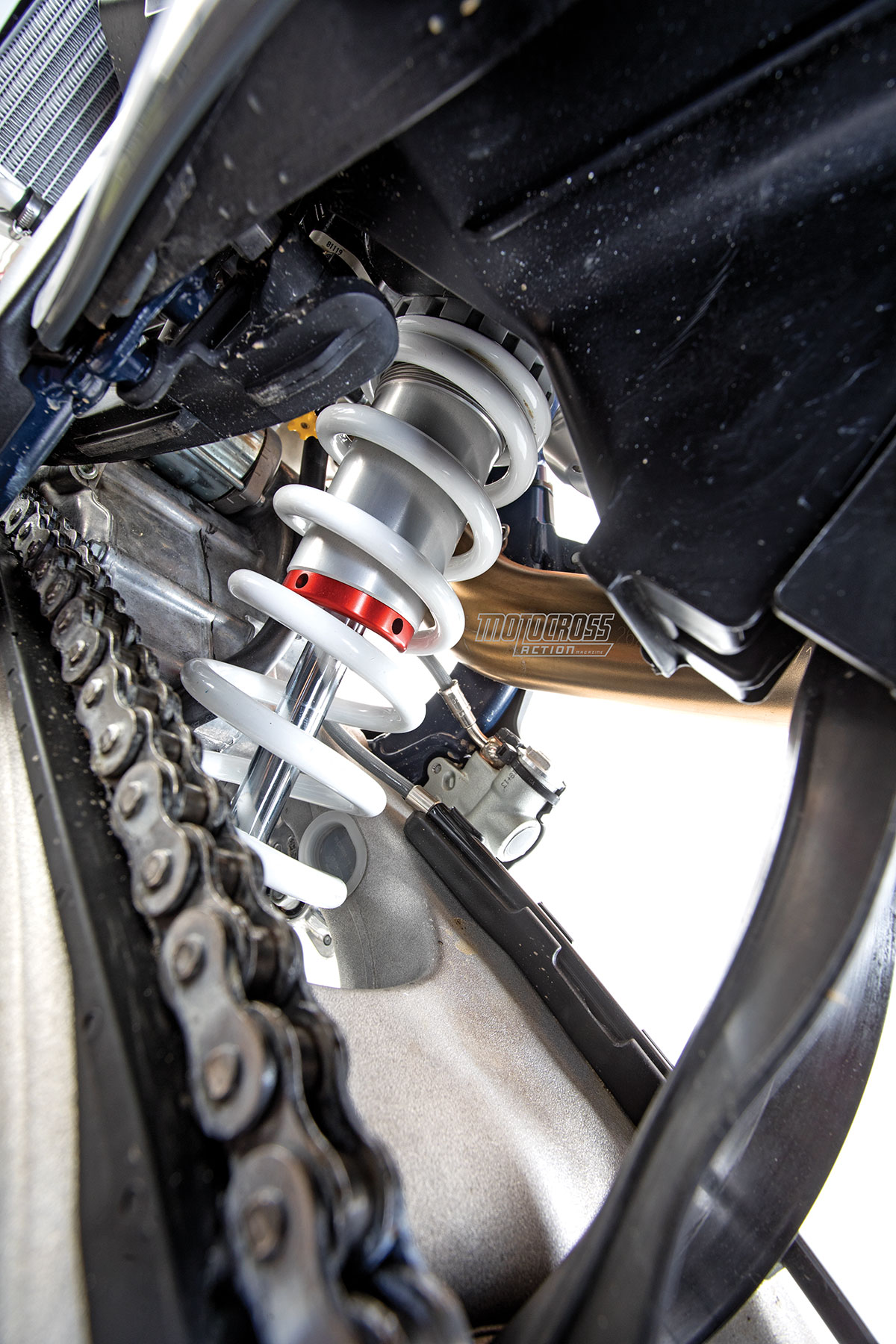
We ran the race sag at 105mm, but some test riders preferred 107mm. The really picky test riders wanted to add a complete Pro Circuit linkage system. The $325 Pro Circuit linkage and bell crank splits the difference on the rising-rate curve of the wallowy 2015 OEM KTM linkage and the overly harsh OEM linkage on the 2016-2020 KTMs but does require a return to the 45 N/m shock spring.
In spite of a little test rider whining, most admitted that the 2020 shock felt a lot suppler than the 2019 shock and that for a rider in the target weight window of the 42 N/m spring, it was a big improvement. To determine if the 42 N/m spring is right for you, measure your free sag. If it isn’t between 30mm and 40mm unladened, you need a different spring rate.

Q: HOW DOES THE 2020 HUSQVARNA FC450 RUN ON THE RACETRACK?
A: Every MXA test rider, Pro, Intermediate, Novice and Vet fell in love with the 2020 Husqvarna powerband. It was incredibly easy to ride. The combination of the plush suspension, which toned down the rigidity of the chromoly frame (that was stiffened up in 2019), along which almost perfect geometry, made the bike a dream to carve around corners. Although everyone loved it, the Pros wanted more immediate hit off the bottom, but, in tests, their lap times were faster on the kinder and gentler Husqvarna powerband than on the more aggressive and rigid 2020 KTM 450SXF. They didn’t care, because they “needed more juice,” and that was the end of the argument.
The strange thing is that the 2020 FC450 engine produces more bottom, more mid and more top than the 2019 Husky FC450. It is noticeably quicker in the transition from low to mid than last year’s engine and doesn’t sign off as soon as the 2019 model. The power is so well modulated that there are no burps, surges or abrupt hits anywhere on the curve. It is easy to go fast when the bike you are riding urges you to keep your speed up. We can’t say that gun-and-run riders will like the powerband as much as the MXA test riders did, but this is a great engine.
On the dyno, the 2020 Husky FC450 made 1 horse more than the 2019 model at 6000 rpm, 1.5 horses more at 7000 rpm, 1.80 horsepower more at 8000 rpm, 2.2 horsepower more at 9000 rpm, 2 horse more at 10,000 rpm and 1.7 horsepower more at 11,000 rpm. Peak horsepower was at 9100 rpm and was up 2 horses.
The biggest killer of what is already a great powerband is the ice-cream-cone-style restrictor in the Husqvarna muffler. Husqvarna welds a rolled-up section of perforated steel into the muffler’s perf core. It kills throttle response. Its existence makes us wonder why Husky would go to so much effort to get better throttle response when all Husqvarna really had to do was run the non-restricted 2019 Husky FC250 muffler on the FC450. KTM, who pioneered the ice-cream-cone restrictors in 2013, dropped them in 2014. Husqvarna doesn’t need them on the motocross bike since it registered 93.2 dB on the 94-dB Amateur sound test and 111.4 dB on the AMA/FIM Pro-level 114 dB two-meter-max test.

Q: WHERE DID THE ADDED POWER COME FROM IN 2020?
A: You might think that very little has been changed on the 2020 Husqvarna save for the suspension setup, but you’d be wrong. Here is a quick list of changes for 2020.
(1) Mapping. When the 2020 Husqvarna was released, the MXA wrecking crew expected it to come with the American map that we had tested with the engineers a couple months before the debut of the 2020. The American map was very crisp, very quick and stronger from low to-mid. The map that the Austrians put in as Map 2 was not the American map (that was easy to tell), but it was an improvement over last year’s Map 2 (typically known as the aggressive map). So, even though we know that there is a much better map out there, we are pleased that the Austrian engineers did at least give us a “watered-down” version, because it helped throttle response, picked up cleaner and filled in the low-to-mid transition to make it easy to get to the next taller gear.
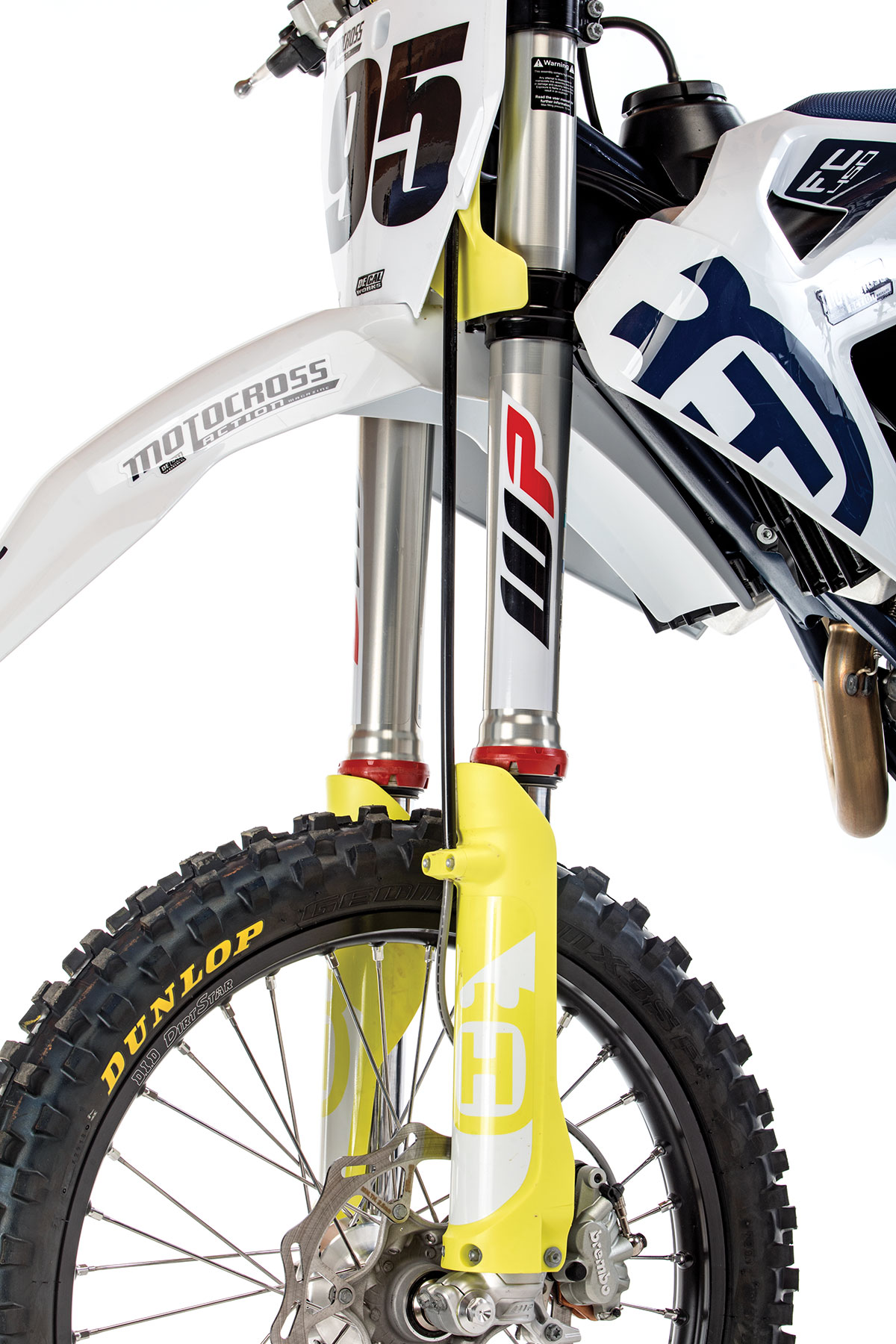
(2) Vented airbox. Much like with the watered-down map, Husqvarna paid lip service to the idea of venting the restrictive airbox cover. While KTM has added 10 sculpted vent holes to its airbox cover and put them in the proper location, Husqvarna added six narrow slots on the upper edge of the airbox cover. It seemed half-hearted to us, and the dyno proved that it was. While the 2020 Husky FC450 was on the dyno, we tested the KTM 450SXF and Husky FC450 with both of their vented and unvented covers in place (the bikes come with both covers). The KTM 450SXF gained an average of 1 horsepower across the complete power curve with the vented cover over the unvented cover. Sadly, Husqvarna’s vented airbox cover only produced more power than the unvented cover from 8500 rpm to 9700 rpm (and even then it was only 0.5 horsepower).
(3) Gearing. To respond to racer complaints that the 2019 Husqvarna FC450 did not jump up into the powerband quickly enough, both KTM and Husqvarna swapped last year’s 48-tooth rear sprocket for a 49 in 2020.
(4) Mechanical parts. The Pankl connecting rod now has a true-to-life bronze top-end rod bushing replacing last year’s coated steel bushing. The rocker arm’s architecture has been redesigned to reduce inertia on the intake and exhaust valves. The piston has stronger bridge-box reinforcements under the piston’s dome and a CNC-machined and hard-anodized ring groove. Plus, the piston’s skirt has been ground down to remove 0.01mm to allow the piston to expand outward more to reduce thrust action on the cylinder sidewalls. If you want a more detailed explanation of the 2020 engine modifications, click here for the 2020 KTM 450SXF test.
Q: WHAT DID WE HATE?
A: The hate list:
(1) Bolts. Check the spoke nipples and rear sprocket bolts at very regular intervals.
(2) Blue frame. The blue frame is not growing on us. It looks old and weathered on the showroom floor, plus Husqvarna covers half of the visible frame parts with black plastic frame guards.
(3) Compression clicker. The three-prong compression clicker has been changed to a two-prong clicker. Guess what? It’s harder to use than the old one. We need longer prongs, not more or fewer of them.
(4) Lock-on grips. We like the ease of use of Husqvarna’s ODI lock-on grips. They are a little firmer than glue-on grips, but we like the ability to fix a torn grip without having to wait for the glue to dry.
(5) Graphics. Those aren’t graphics; they look like a mistake on the assembly line.
(6) Vented airbox. If Husqvarna’s engineers didn’t want to vent the airbox cover, they shouldn’t have done it. But, if they chose to do it, they should have developed a test program that put the vents in the proper location and in sufficient numbers to get the obvious benefits of more air. We are not okey-dokey with fake vents.
(7) Seat bolt. You have to remove the airbox cover to get to Husqvarna’s very unique single seat bolt. We use a hole drill bit to make an access hole in the airbox cover to get to the bolt without playing tug of war with the Husky airbox cover.
(8) Airbox cover. Speaking of the airbox covers, the Husky one is so long that when you try to remove it, it fights back. We really had to tug to get it off, which often led to flicking the neoprene plug-in receivers across the pits. Worse yet, when you put the cover back on the bike, the front edge of the cover has to go in front of the front edge of the airbox. This isn’t as easy as it sounds. Once you get the front of the cover in the correct spot, you have to get the molded plastic hook on the rear edge of the airbox cover hooked under the body panel. If you ham-fist this action, the plastic hook breaks off and your airbox cover flaps in the breeze.
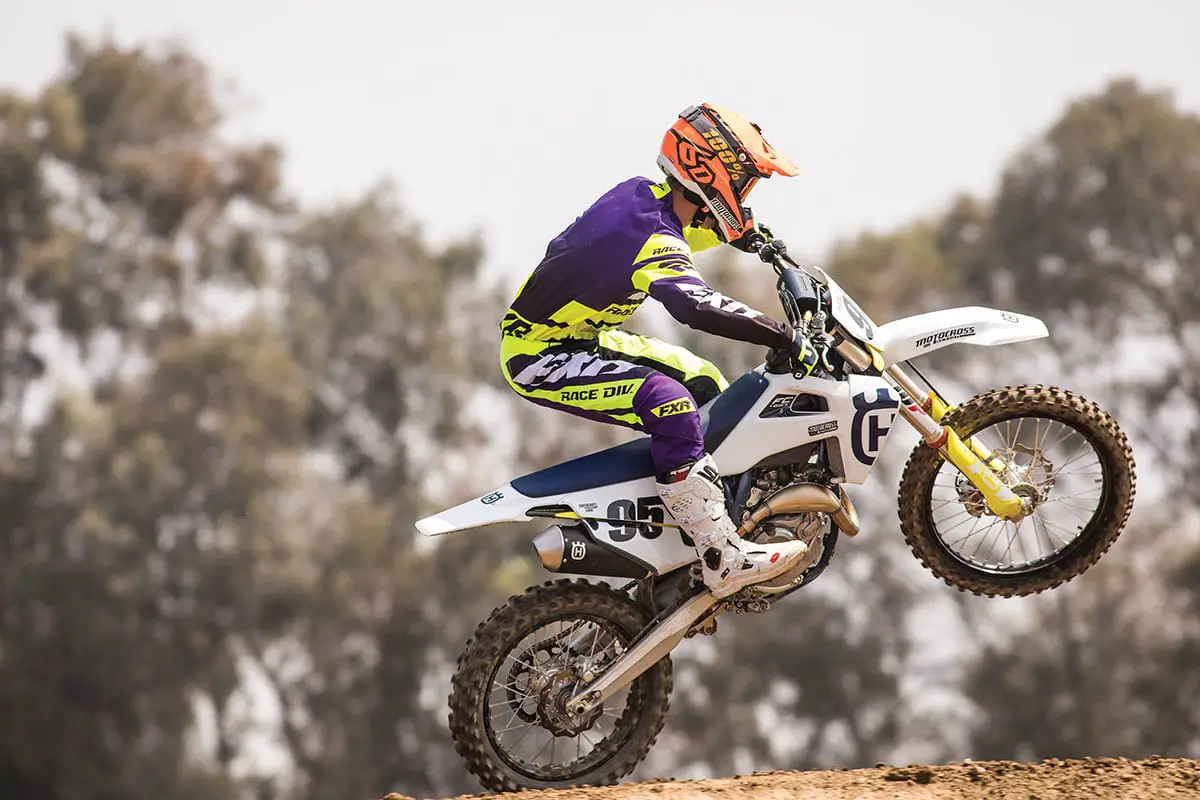
Q: WHAT DID WE LIKE?
A: The like list:
(1) Magura hydraulic clutch. Over the past few model years, the Magura clutch slave cylinders suffered lots of seal failures. For 2020, Magura changed the seal design. This is good news. We love the KTM/Husqvarna hydraulic clutches. From the CNC-machined basket to the Belleville washer, this clutch is bulletproof. The major difference between the Magura and Brembo clutch is that the Magura clutch pull feels smoother and more linear, while the Brembo has that pop feel that tells the rider when the clutch is disengaged
(2) Electric starting. KTM has had electric starting since 2007, and Husky benefits from KTM’s experience.
(3) Traction control, launch control, two maps. KTM and Husky are the only brands with a push-button, on-demand traction-control setting (that can be used with either the mellow or aggressive maps). Plus, the same button controls launch control and switches between two maps, which can be done on the fly.
(4) Brembo brakes. The “Big Four” Japanese brands have been throwing 270mm rotors on their old-fashioned master cylinders and calipers to try to keep the Brembo brakes in sight.
(5) Weight. At 224 pounds, the 2020 Husqvarna is 14 pounds lighter than the 2020 CRF450 and YZ450F. If you don’t think that 14 pounds make a difference on a race bike, you need to take up tiddlywinks.
(6) Pankl gearbox. The Husqvarna gearbox is manufactured by Formula 1 transmission supplier Pankl. Enough said.
(7) Throttle cam. Your Husky sat on the showroom floor with the stock, long-throw throttle cam installed. Take it out and put on the quick-turn black throttle cam that your dealer gave you on the way out the door.
(8) Frame stiffness. When the 2019 frame was stiffened up, it was not a slam dunk for riders who preferred the more comfortable 2018 frame; however, Husqvarna’s new suspension settings muted the 2020 head tube’s rigidity to feed the resilience back in.
(9) Twin Air filter. If you’ve ever installed an air filter into a KTM or Husqvarna, you will be amazed at how foolproof it is compared to the normal gymnastics of other air filter/cage/airbox designs.
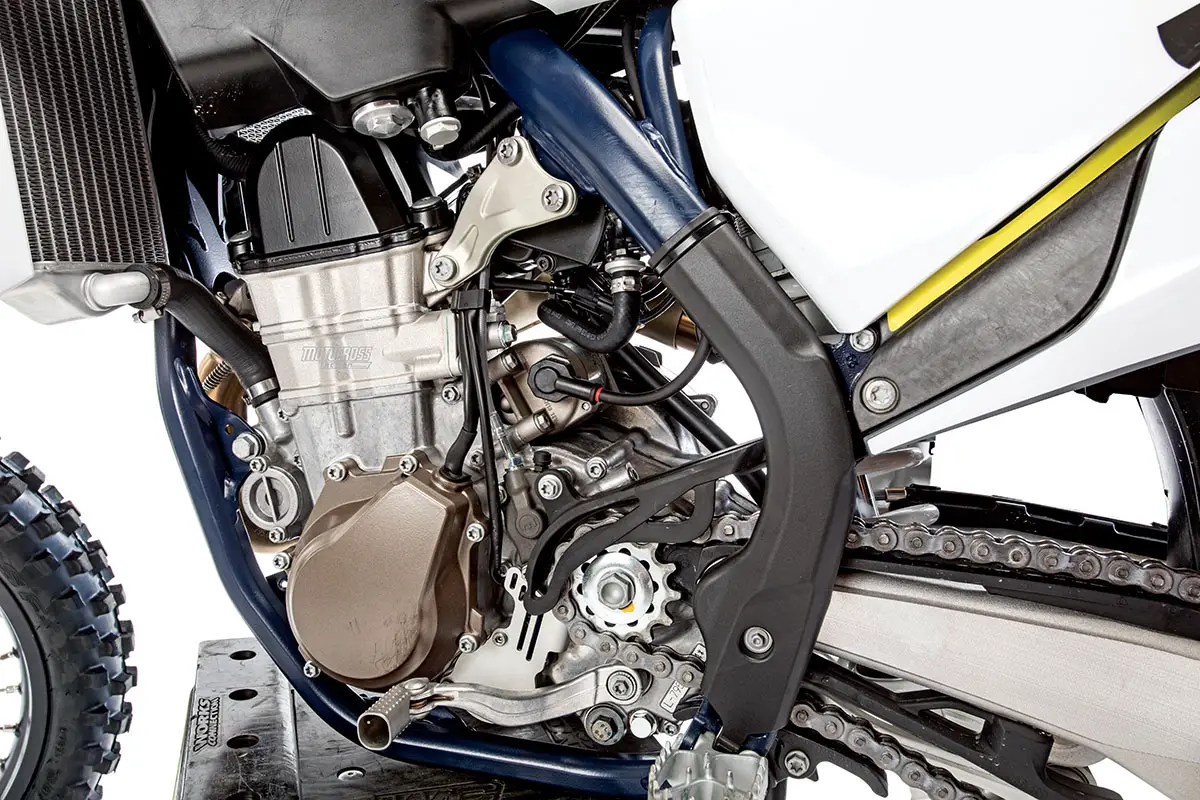
Q: WHAT DO WE REALLY THINK?
A: We love this bike, with a knowing nod to the suspension stiffness concerns of Pro riders. Last year we questioned why Husqvarna’s engineers would build a motocross bike with a restrictive muffler and airbox, especially since these two issues are easily resolved (even by the consumer). Those two issues still remain in play for 2020, but Husqvarna beefed up the low-to-mid transition, softened the suspension to provide a more fluid ride, fixed the Magura clutch seal issues, added a more responsive Map 2, pumped up the horsepower across the curve and improved chassis control to the point of making the handling effortless.
On second thought, love isn’t a strong-enough word to describe how good the 2020 Husqvarna FC450 feels when it is in the hands of its target audience.

MXA’S 2020 HUSQVARNA FC450 SETUP SPECS
This is how we set up our 2020 Husqvarna FC450 for racing. We offer it as a guide to help you find your own sweet spot.

AER FORK SETTINGS
Husqvarna’s prime demographic is Vets, Over-40 and Over-50 riders. Why? Older riders can remember the glory days of Husky and are rich enough to pay the premium price. In last year’s 2019 Husqvarna FC450 test we wrote, “Husqvarna should make its fork setup considerably softer than the current base settings. Yes, we know that there are fast riders on Husky FC450s, but very few fast guys run stock suspension‚ regardless of the brand they race.” And that is exactly what the Husqvarna engineers did to the suspension setup of the 2020 FC450. Just because the suspension is softer than it was last year doesn’t relieve the owner of the responsibility to find his perfect air pressure, clicker settings and fork height.
For hard-core racing, we recommend this fork setup for an average rider on the 2029 Husqvarna FC450 (stock specs are in parentheses):
Spring rate: 145 psi (152 psi)
Compression: 15 clicks out (12 clicks out stock)
Rebound: 10 clicks out (12 clicks out stock)
Fork-leg height: Third line
Notes: Pay attention to extreme temperature changes. It doesn’t hurt to reset the air pressure to your chosen settings between motos (once the forks have cooled down from riding). Bleed the outer chambers at regular intervals.
WP SHOCK SETTINGS
For 2020, Husqvarna added a lighter 42 N/m spring (last year’s spring was 45 N/m). The compression damping was increased (to compensate for the lighter spring rate), and the rebound was reduced (to compensate for the lighter spring’s motion in the opposite direction). Most MXA test riders added more high-speed compression and more rebound. MXA test riders don’t stray far from the stock 15 clicks out on low-speed compression, relying on the high-speed and rebound adjustments to have a crossover effect on the whole shock.
For hard-core racing, we recommend this shock setup for the 2020 Husqvarna FC450 (stock specs are in parentheses):
Spring rate: 42 N/m (45 N/m for over 185 pounds; 48 N/m for over 210 pounds)
Race sag: 105mm
Hi-compression: 1-1/4 turns out (1-1/2 turns out stock)
Lo-compression: 15 clicks out
Rebound: 10 clicks out (15 clicks out stock)
Notes: We turned the high-speed compression damping in a 1/4 turn to lessen G-outs and ran more rebound than the recommended setting. Additionally, some test riders ran the race sag at 107mm and slid their forks up 2mm to get the bike down in the corners.


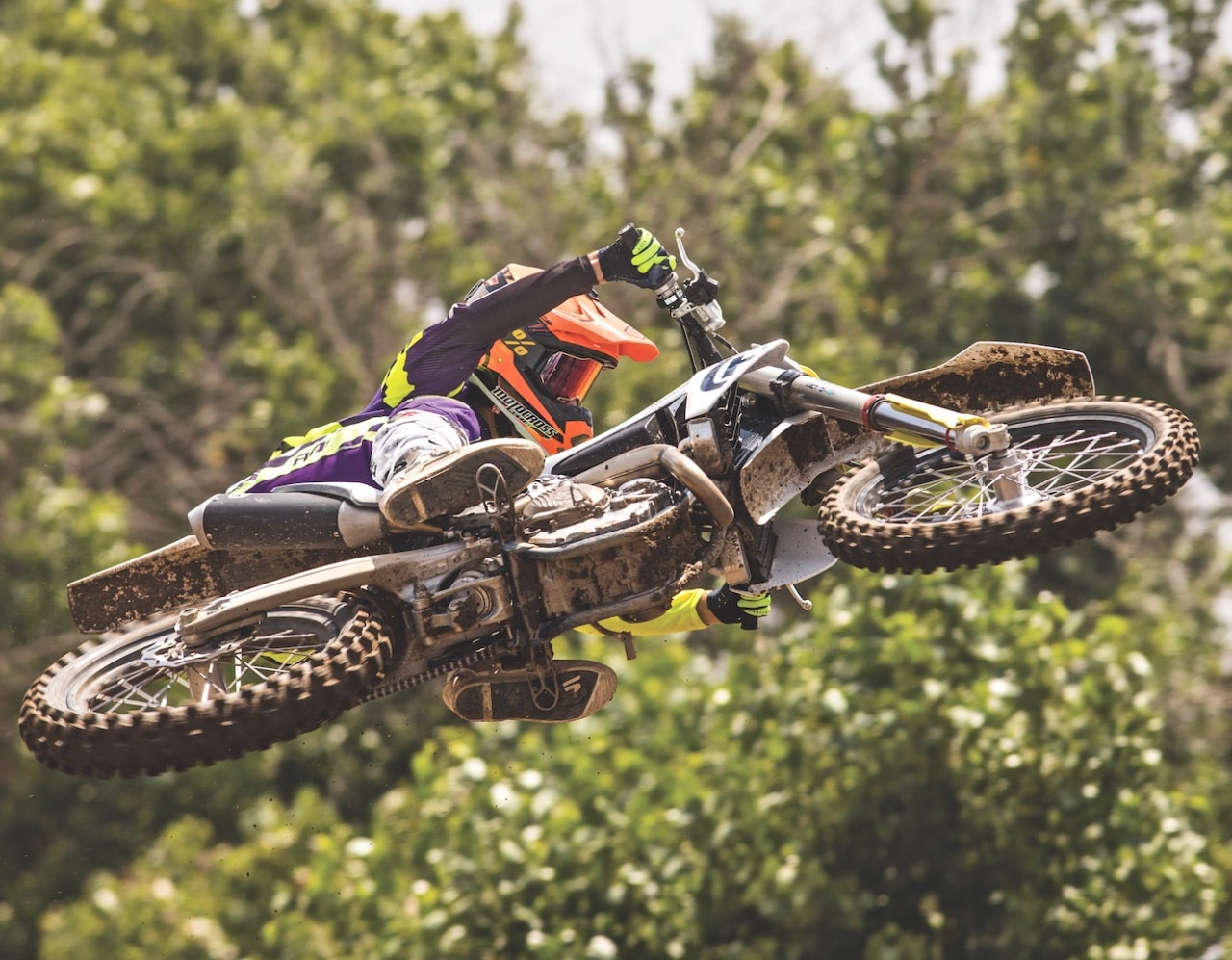


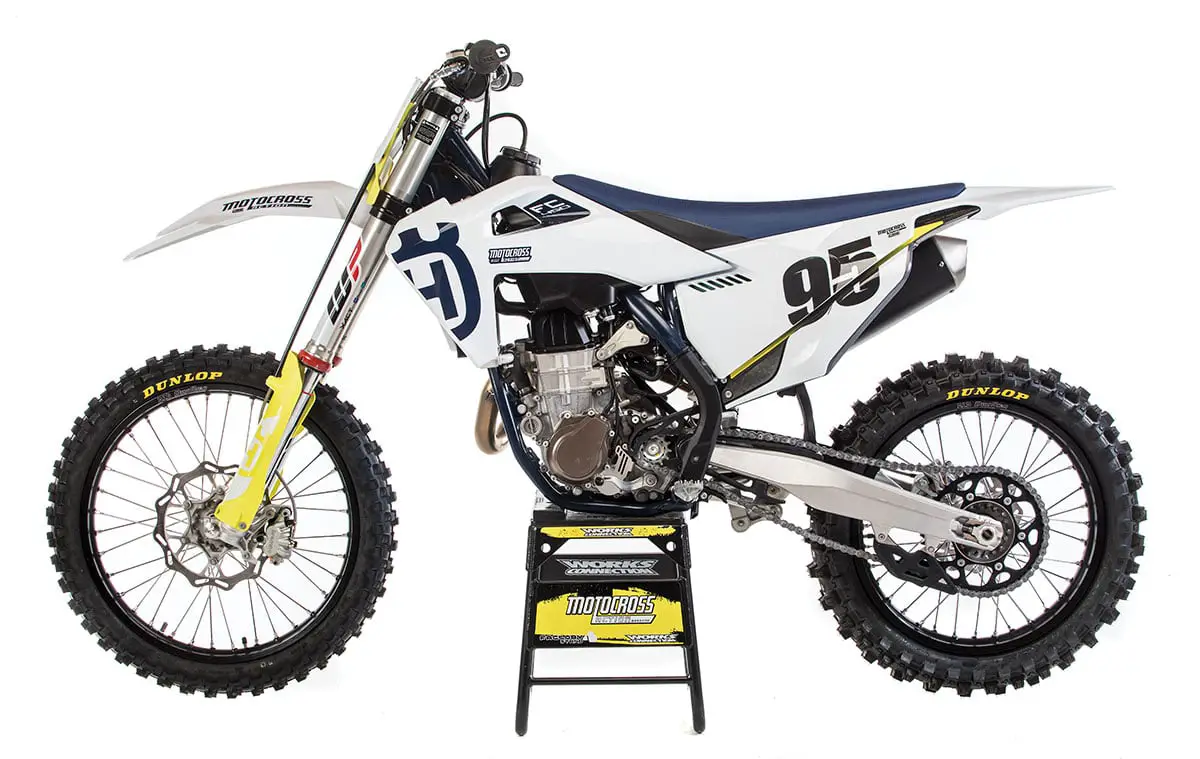


Comments are closed.